This projects was intended to see to what extent of abuse an original Honda B18B motor could handle as a turbo motor, using carefully modified OEM parts.
To date the customer has done over 40 000 miles hassle free, and has now sold the car to build a CRX.
The Build-up
In all circumstances parts of an engine that we deal with everyday, hold a predetermined amount of potential. Some of these are at their ‘limits’, other still have a way to go.
In the automotive manufacturing process, in a normal mass production run, the OEM’s primary concern is cost. With this in mind, if a part passes the minimum tolerance / quality specification, then it is used. It is this mindset from the OEM manufactures that allows us ‘room’ for improvement, even on their OEM parts.
With this project we have undertaken the task of using all OEM parts, with some slight ‘massaging’ for improvement, to build a 250kW motor that would be reliable in an everyday use situation. Honda has also been very generous by providing us with a very good base to start from.
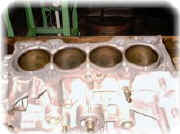
Here we start with the block. Certain precautions are being taken, and we start by modifying the block by re-enforcing it, giving it strength in the major thrust areas of the cylinder wall.
For the well trained eye, here we can see the block after it has been re-enforced.
As with all our ‘high output’ motors, they get sent in for full balancing, there 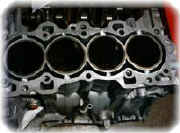 after to the machine shop, where everything else is done according to our specification. Once everything returns, it is then when the ‘real’ work begins.
after to the machine shop, where everything else is done according to our specification. Once everything returns, it is then when the ‘real’ work begins.
This is a view of an OEM Honda connecting rod that has received some treatment to make sure that there are no flaws, and obviously to strengthen the rod to a certain degree.

As with everything attention to detail is critical, and here Claudio takes on the task to make sure everything is as clean as can be, by using an ear bud to get into the corners.


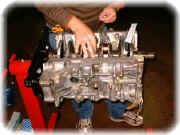
In these series of photos, plasti-guage is being used to do a final clearance check on every bearing journal. They all measured 0.04mm clearance.
Next on the agenda were the cylinder bores, making sure of their sizes, and matching each piston to the relevant cylinder for an exact piston to wall clearance.
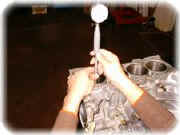
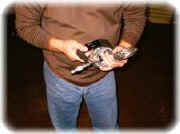
Once again, detail! Here we make sure that there are no sharp edges, and the whole assembly gets de-burred.
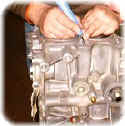


After making sure that the ring end gaps are all the same, and within specification they are placed on the pistons, and the pistons placed into their relevant bores.




With the majority of the power being made by the configuration on the cylinder head, it is only obvious that most of the modifications to the engine to gain power was done in this area.
The head was then sent for a 3-way valve job, a slight cut on the surface, new seals, and assembled. Making sure that everything was in order as we went along.
 This is a final picture of the short block before the cylinder head is put on, and everything being closed up, and torqued down. OEM pistons were also used in this application, but obviously some slight alterations were done to the domes, to try and improve the combustion process.
This is a final picture of the short block before the cylinder head is put on, and everything being closed up, and torqued down. OEM pistons were also used in this application, but obviously some slight alterations were done to the domes, to try and improve the combustion process.
Once closed up, the motor then received a set of Web cams, some adjustable cam gears, and a slightly modified KKK Turbo to help with the breathing of the whole combination.
This engine’s next home is now in the engine bay of a ’94 AMG Honda.
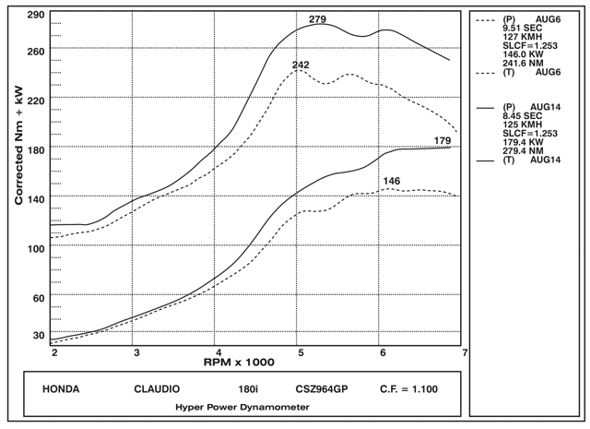
This was the end result!
The above graph is the Dyno Graph of the daily driven B18b motor. The power you see is what the owner has available to him on an everyday basis using only OEM parts supplied to us by Honda which we slightly modified.
As we previously described, with slight modifications to the original parts, this is the end result.
The 179Kw as indicated on the graph was produced at the wheels, at 0.65 Bar of boost on normal 93 octane pump fuel 5,500 feet above sea level. The other figure of 146Kw was achieved before we dialled in the cam gears.
There was only one limitation during our Dyno tests, and that was the rev. limiter. As you might notice the car was still producing power at the end of the RPM range. I don’t think that the motor would have made more than one extra kilowatt had we revved higher, but rather would have maintained a ‘flat’ power curve. The advantage would be that during gearshifts, by revving higher, you would start your next gear pull at a power output very close to maximum.
And for those that are curious and interested in knowing, the motor, using race fuel, needed 1.4 bar boost to belch out 238Kw at the wheels with this combination.
